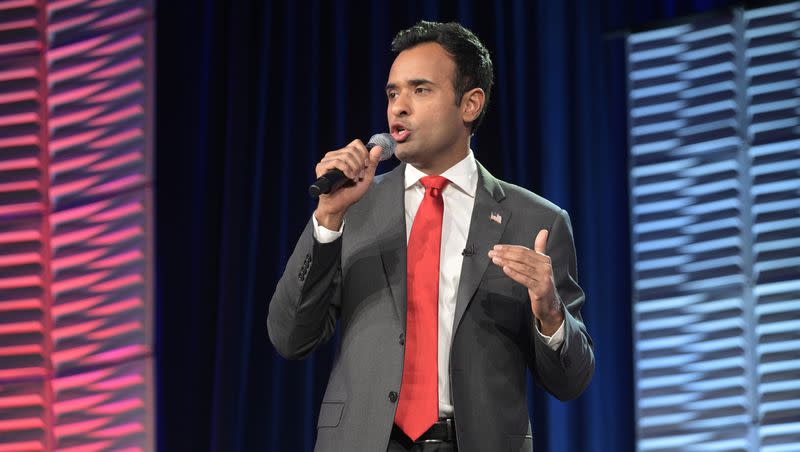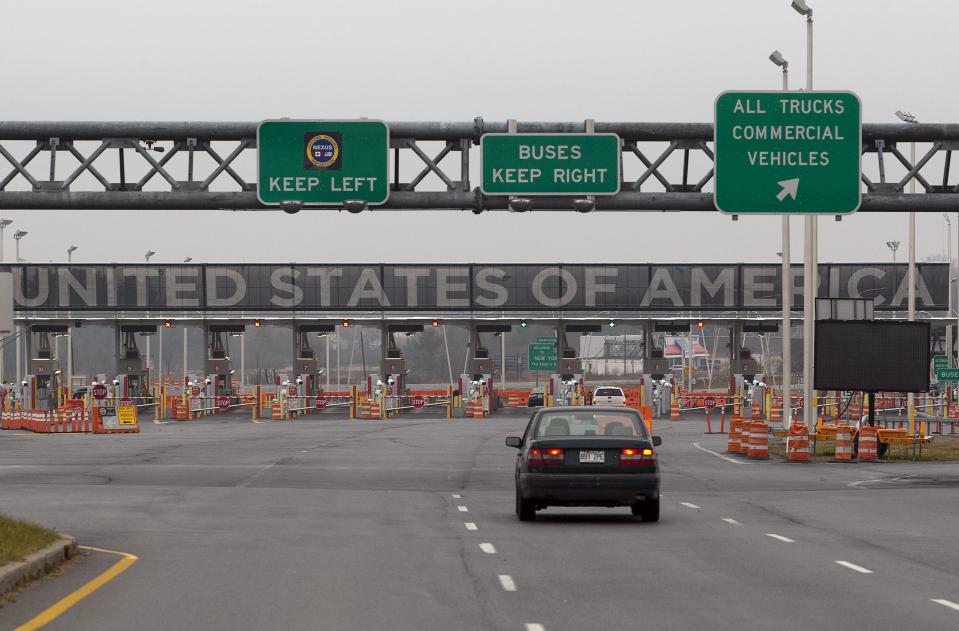Vivek Ramaswamy wants to build a border wall between U.S. and Canada ... and make Central America pay for it

- Oops!Something went wrong.Please try again later.
- Oops!Something went wrong.Please try again later.
This article was first published in the On the Trail 2024 newsletter. Sign up to receive the newsletter in your inbox on Tuesday and Friday mornings here.
Good morning and welcome to On the Trail 2024, the Deseret News’ campaign newsletter. I’m Samuel Benson, Deseret’s national political correspondent.
If you missed it, I spent a weekend with a Jewish society at Yale that counts Vivek Ramaswamy and Cory Booker among its members. Ramaswamy, a Hindu, has been slammed for his foreign policy toward Israel. I wanted to know: Where did his relationship with the Jewish state begin? Read more here: Inside Yale’s Jewish society that shaped Vivek Ramaswamy.
And on Wednesday night, I watched the GOP debate with Jon Huntsman Jr. — the 2012 presidential candidate and ex-ambassador to China and Russia. He was candid and insightful. Read what he thought here or watch a video recap here.
Here’s more of the Deseret News’ 2024 election coverage:
Sen. Joe Manchin won’t seek reelection, teases presidential run
Republicans address abortion, Israel, Social Security and the border in 3rd debate
This is who Romney says he’ll vote for if it’s Trump vs. Biden again
The Big Idea
Build the Wall ... With Canada?

Tough-on-immigration Republicans have begun testing a new applause line: We should build a wall on the southern border, they say. And while we’re at it ... why not build a wall between us and Canada?
The biggest advocate, thus far, has been entrepreneur Vivek Ramaswamy. During the presidential debate Wednesday, he pitched the idea: “Don’t just build the (southern) wall,” he said. “Build both walls.” He’s been harping on this for several months now — during a trip to northern New Hampshire in early October, he decried a “fast-growing crisis” along the world’s largest land border between two nations and claimed that illicit drugs, like fentanyl, were flowing across it at alarming rates.
He’s not the only one. Nikki Haley, the former U.N. ambassador and South Carolina governor, has shown support for beefing up northern border security, too. During the second debate, she said the U.S. should be working to “secure the border: the southern border, the northern border, period.” Her campaign did not respond to a request for elaboration on her northern border policy.
Ramaswamy, however, was eager to talk. During a recent phone call, he explained to me that the U.S.-Canada border is “wide open,” referencing his visit to Colebrook, N.H., last month. There, Gov. Chris Sununu has announced a tenfold increase in officers along the state’s border with Canada, combatting a reported uptick in illegal crossings.
During fiscal year 2022, nearly 6,000 unauthorized border crossers were apprehended while trying to enter New Hampshire, Vermont or New York, an increase of over 700% from the same period during the previous year, when around 800 individuals were apprehended.
Sununu, who has been called a moderate Republican, is pulling state, county and local law enforcement officers to monitor the border, a responsibility usually handled by federal agents. “The Federal Government refuses to take action on our Northern Border,” Sununu said in a statement. “They cut funding, limited our resources, and have thrown their hands up. Without adequate federal support, the state is stepping up.”
Ramaswamy’s plan? Build a wall. How would we pay for it, I asked? “Well, the U.S. can directly pay for it, but effectively get indirect funding from a lot of the people who are responsible for the creation of that crisis.”
He clarified: “I think much of this even takes a look at Central American aid that has not been fulfilling its current purpose. Many of those people are flying to Canada to come over, that’s what we’re seeing now.”
I asked which specific countries would see their aid slashed.
“I would say overall reductions in foreign aid, but I was particularly referring to Central America,” he said.
But Ramaswamy’s calculus doesn’t compute on several fronts. Some quick thoughts:
Central Americans are a small portion of northern border-crossers. Yes, the U.S. saw record numbers of apprehensions at the northern border in August and September of this year — 19,834 and 18,852 (across the entire border, not just the northeast segment Ramaswamy visited). But less than 2% of those were of Central American origin, according to data from Customs and Border Patrol: 206 in August and 278 in September.
Foreign aid goes through Congress. The federal government’s budget — which includes funding to the State Department and USAID — is approved by Congress before reaching the president’s desk. If Ramaswamy were to reallocate aid to Central American countries in favor of a border wall, he would need to get majorities in both congressional chambers on board. Congress has the authority to determine where it wants aid to go — so if, say, it earmarked humanitarian aid for Guatemala or El Salvador, the White House wouldn’t be able to use those funds for border infrastructure.
A northern border wall would be pricy — perhaps much more than Ramaswamy anticipates. The Trump administration put aside $15 billion for a border wall along the southern border and planned to build 738 miles of fencing, costing about $20 million per mile. In reality, it completed less than 500 miles, at a much higher price tag (up to five times the anticipated costs in some areas). Even if we use that baseline figure of $20 million per mile, the cost of a wall across the U.S.-Canada land border — a full 5,525 miles — would surpass $110 billion. The total cost of U.S. foreign aid allocated in the 2022 budget was only $58 billion — just over half of the estimated cost of this wall. And not a single Central American country was within the U.S.’ top ten recipients of foreign aid. This would be an expensive wall, and “cuts to foreign aid” would not come close to funding it.
Never mind that militarizing a border may actually be counterintuitive, if the goal is decreasing illegal immigration. It seems clear that any plans to build a wall between the U.S. and Canada may require a bit more thought.
Ad of the week
Larry Hogan, who recently completed his second term as a Republican governor of deep-blue Maryland, launched an ad this week.
Hogan hasn’t announced his candidacy yet. But he’s repeatedly praised No Labels and refuses to shut the door on a potential 2024 run. I don’t think this is the last Hogan ad we’ll see.
Weekend reads
This week’s elections were great for Democrats and horrid for Republicans. Perhaps most encouragingly for Dems, they found a winning message on abortion — and a potential cheat-sheet of how to win over Trump-dominated districts ahead of 2024. Beshear’s win in Kentucky shows, once more, Democrats aren’t extinct in Trump states (Zach Montellaro, Politico)
An interesting profile of Chris Murphy, the enigmatic senator from Connecticut. He’s paired up with Mitt Romney on student athlete compensation and with Mike Lee on challenging Saudi Arabia. Now, he’s working to fix America’s mental health problem — cracking down on opioids, addressing loneliness and making the U.S. a happier place. Chris Murphy Wants To Make America A Little Less Lonely (Eric Lutz, Vanity Fair)
It seems the political center has vanished. But the extremes are in disarray, too. Right-wing populism is inextricably attached to Trump, and left-wing progressives can’t seem to agree on Israel-Palestine, the geopolitical issue of the moment. Two new books address this chaotic moment, and this smart review dives in: “It appears that we are in a time of interregnum in American politics. Yet interregnums can be productive for reformers.” The Quest for a New New Deal (Ryan Zickgraf, Compact)
Have a question for next week’s mailbag? Drop me a line at onthetrail@deseretnews.com, or reply to this email.
See you on the trail.
Editor’s Note: The Deseret News is committed to covering issues of substance in the 2024 presidential race from its unique perspective and editorial values. Our team of political reporters will bring you in-depth coverage of the most relevant news and information to help you make an informed decision. Find our complete coverage of the election here.

